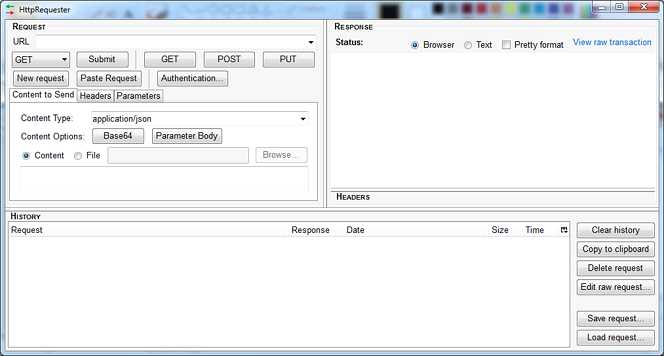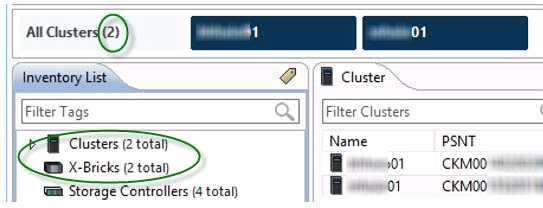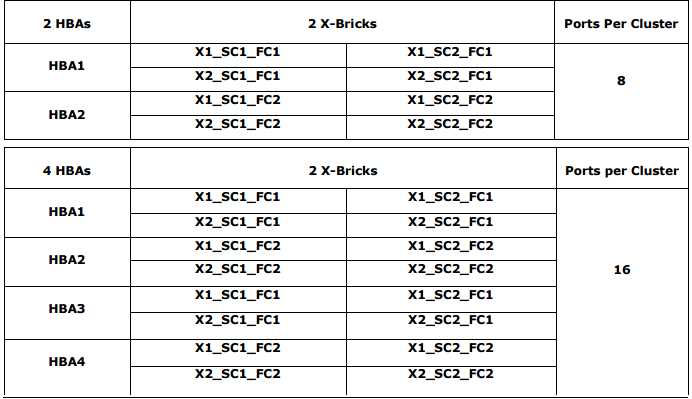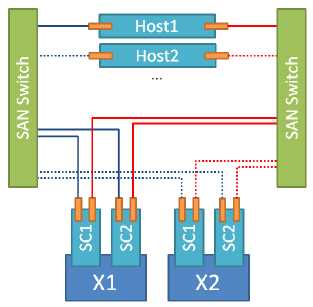Dell EMC E20-526 Exam Questions
Questions for the E20-526 were updated on : Jul 02 ,2025
Page 1 out of 5. Viewing questions 1-15 out of 67
Question 1
When using the XtremIO PoC Toolkit, what is the purpose of the Age phase?
- A. Continuously write to a specific range of logical block addresses to test Flash durability
- B. Overwrite each LUN multiple times to ensure they contain all unique data
- C. Test the performance of the All-Flash array with non-production static data
- D. Scatter writes across the entire array to simulate ordinary use of the system
Answer:
D
Explanation:
Proceed with filesystem aging by doing random overwrite cycles.
Question 2
A user attempts to create a quorum disk for a host cluster. Volume parameters are:
However, the volume creation fails. What caused the process to fail?
- A. Quorum disks cannot have an 8kB block size
- B. Volume size is too small
- C. Volume name is invalid
- D. XtremIO volumes cannot be quorum disks
Answer:
B
Explanation:
The volume size must be specified in MB, GB, TB, and not in KB.
Question 3
You have been asked to design an XtremIO storage array solution that will be used for two large
applications workloads. One overload will generate approximately 150,000 write IOPs with an
average 4 kB I/O size. The second write workload will have an average I/O size of 128 kB and will
generate approximately 2 GB/s of throughput.
At a minimum, how many X-Bricks are needed in a single cluster to meet this requirement?
- A. 2
- B. 4
- C. 6
- D. 8
Answer:
A
Explanation:
Second write workload IOPS = 2 GB/s divided by 128 kB = 2 x1,073,741,824 / (128 x 1,024) = 16384
IOPs.
Total IOPS required would be 150,000, from the first workload, plus 16384, totaling 166384.
A 2 X-Brick cluster provides 300K Read/write IOPS so it would be adequate.
Storage capacity and performance scale linearly, such that two X-Bricks supply twice the IOPS, four X-
Bricks supply four times the IOPS, six X-Bricks supply six times the IOPS and eight X-Bricks supply
eight times the IOPS of the single X-Brick configuration.
Note: Choose an EMC XtremIO system and scale out linearly by adding more XtremIO X-Bricks.
References:
https://store.emc.com/en-us/Product-Family/EMC-XtremIO-Products/EMC-XtremIO-All-
Flash-Scale-Out-Array/p/EMC-XtremIO-Flash-Scale-Out
Question 4
How can REST API commands be run to manage and monitor an XtremIO cluster?
- A. From the REST API CLI built into each X-Brick
- B. From the REST API GUI built into each X-Brick
- C. From a third-party GUI
- D. From the REST API tab in the XMS GUI
Answer:
C
Explanation:
The XtremIO's RESTful API allows HTTPS-based interface for automation, orchestration, query and
provisioning of the system. With the API, third party applications can be used to control and fully
administer the array.
Normally you would access the API using some form of programming/scripting language, such as
Python or Perl. However for the purposes of learning or testing concepts there are a number of tools
that work better, such as HTTPRrequester and curl.
* Curl is a command-line tool that exists in all Linux distributions, and is available for most other Unix
OSes as well as Windows.
To use curl to access XtremIO youll need to pass it a few options, such as the username/password to
access the array (any valid account on the XtremIO XMS will work), the URL of the API, and
potentially a few options such as -k to tell curl not to validate the SSL certificate (presuming you dont
have a valid certificate installed), and -s (silent) to stop curl displaying its progress as it downloads
the response.
* HTTPRequester is a browser extension that is available for both Chrome and Firefox.
As with for curl, youll need to provide a username/password, which is done by clicking on the
Authentication box, which adds two boxes below the URL for the username and the password.
References:https://blog.docbert.org/using-the-xtremio-rest-api-part-1/
Question 5
How should a storage administrator navigate to different XtremIO clusters from the XMS GUI if the
administrator has more than one cluster managed by the same XMS?
- A. Click the Cluster Name on the Menu bar near the top of the screen
- B. Click the Inventory List button on the Menu bar
- C. Click the Administration tab and locate the Cluster Name
- D. Click the Cluster Name on the Status bar at the bottom of the screen
Answer:
B
Explanation:
From the menu bar, the Inventory icon is to be clicked to display the Inventory workspace. This
workspace takes the place of the Hardware workspace in earlier versions of the XtremIO GUI. With
the All Clusters tab selected, we can see a list of all the hardware elements in the managed clusters.
Note: With time, additional clusters can be added to a deployed XMS. In addition, a cluster can be
easily moved from one XMS to another. All management interfaces (GUI/CLI/REST) offer inherent
multi-cluster management capabilities. Multiple cluster management is supported from version 4.0
and up.
References:
https://community.emc.com/community/connect/everything_oracle/blog/2015/08/27/xtremio-40-
multi-array-management
Question 6
A customer has a large ESX server environment they are considering deploying to XtremIO for a VDI
implementation. To determine a baseline of the environment, you are proceeding with documenting
each servers CPU, NIC, and disk utilization statistics. The customer has provided you with direct CLI
access to the servers to conduct this assessment.
Which utility should be used to monitor these performance parameters?
- A. esxtop
- B. resxtop
- C. top
- D. iostat
Answer:
B
Explanation:
resxtop is a command to retrieve performance statistics. This command is included in vSphere
command line interface (CLI) and is part of the vSphere Management Assistant (vMA), which is an
equivalent to esxtop that runs only inside an ESX service console.
Question 7
A customer has recently purchased an XtremIO 10 TB single X-Brick cluster for an implementation of
Oracle RAC. The customer wants your help with integrating Oracle with their new XtremIO cluster.
The customer has three DATA disk groups, two REDO disk groups, and four FRA disk groups.
How many XtremIO LUNs should be assigned to the FRA disk groups?
- A. 2
- B. 4
- C. 6
- D. 8
Answer:
D
Explanation:
Best practice is to use four LUNs for the DATA disk group to allow the host to use simultaneous
threads. The REDO and FRA disk groups should use two LUNs each.
References:https://community.emc.com/community/connect/everything_oracle/blog/2016/03/31/b
est-practises-of-vblock-on-xtremio-with-oracle-databases-part-i
Question 8
Which multipathing software is supported by XtremIO?
- A. PowerPath/VE and NMP on ESXi hosts
- B. MPIO on non-clustered Microsoft Windows hosts only
- C. PowerPath/VE on Microsoft Windows VMs hosted by ESXi
- D. Native MPIO on IBM AIX clusters
Answer:
A
Explanation:
Noting the inefficiencies in VMwares NMP driver, EMC developed a set of drivers specifically
designed to overcome these limitations and improve the performance and reliability of the data
passing between an array and a server. EMC developed the PowerPath family of products optimized
specifically for Linux, Microsoft Windows, and UNIX Operating Systems as well as PowerPath/VE for
VMware vSphere and Microsoft Hyper-V hypervisors.
PowerPath is installed on hosts to provide path failover, load balancing and performance
optimization VPLEX engines (or directly to the XtremIO array if VPLEX is not used).
Note: VMware, with the cooperation of its storage partners, developed a Native Multipathing Plug-in
(NMP). VMware NMP was designed to distribute the load over all the available paths and provide
failover protection in the case of path, port or HBA failure, but it has not been fully optimized to work
with the controllers in a storage systems. VMwares NMP Round Robin policy does not have the
intelligence that PowerPath has as PowerPath uses testing and diagnostics to continually monitor an
environment to determine the optimal path for queuing requests and will adapt to current
conditions.
References:https://www.emc.com/collateral/analyst-reports/emc-taneja-group-powerpath-tb.pdf
Question 9
Based on best practice, what is the maximum number of paths a host should have to an XtremIO
volume?
- A. 4
- B. 8
- C. 16
- D. 32
Answer:
C
Explanation:
The recommended maximum number of paths to storage ports per host is 16 as per the table below.
References:https://www.emc.com/collateral/white-papers/h14475-wp-xtremio-brocade-best-
practices.pdf?isPublic=false, page 12
Question 10
A new 500 GB VM disk is created on a database that resides on an XtremIO LUN. The VMware
administrator plans to provision the disk using the thick provisioned eager zeroed format.
How much physical XtremIO capacity will be allocated during this process?
- A. 5 GB
- B. 10 GB
- C. 50 GB
- D. None
Answer:
D
Explanation:
XtremIO storage is natively thin provisioned, using a small internal block size. This provides fine-
grained resolution for the thin provisioned space.
All volumes in the system are thin provisioned, meaning that the system consumes capacity only
when it is actually needed. XtremIO determines where to place the unique data blocks physically
inside the cluster after it calculates their fingerprint IDs. Therefore, it never pre-allocates or thick-
provisions storage space before writing.
References: Introduction to the EMC XtremIO STORAGE ARRAY (April 2015), page 22
Question 11
A customer wants to purchase an XtremIO array. After the array is installed, the customer wants to
initially disable encryption. What is the result of enabling encryption on an array that is already being
used?
- A. Data will remain in place but the XtremIO cluster services will need to be temporarily shutdown.
- B. Data will remain in place and there will be no interruption to the XtremIO cluster services.
- C. Data will be erased but there will be no interruption to the XtremIO cluster services.
- D. Data will be erased and the XtremIO cluster services will be temporarily shutdown.
Answer:
A
Explanation:
Disable Encryption and Non-Encrypted Models
This version [Ver. 4.0.2-65] allows disabling the Data at Rest Encryption (DARE), if desired. Disabling
and Enabling is done when the cluster is stopped.
References:
https://samshouseblog.com/2015/12/29/new-features-and-changes-in-xtremio-ver-4-0-
2-65/
Question 12
An XtremIO administrator is having a problem with performance and is troubleshooting the issue.
What is an accurate statement about I/O transfers?
- A. As I/O size increases, IOPs increase, and latency increases
- B. As I/O size increases, IOPs decrease, and bandwidth increases
- C. As I/O size decreases, IOPs increase, and bandwidth increases
- D. As I/O size decreases, IOPs decrease, and latency increases
Answer:
A
Explanation:
Large block I/O by nature incurs higher latency.
References: Introduction to the EMC XtremIO STORAGE ARRAY (April 2015), page 6
Question 13
You are designing an XtremIO solution for a potential customer. If the server and storage information
is available, which information should be documented regarding the customers capacity
expectations?
- A. Capacity requirements on a per data center basisExpandability/scalabilityPerformance requirements determined on a server-to-server basis
- B. Capacity requirements on a per volume basisExpandability/scalabilityPerformance requirements determined on a server-to-server basis
- C. Capacity requirements on a per volume basisCompression rates/scalabilityPerformance requirements determined on a server-to-server basis
- D. Capacity requirements on a per data center basisExpandability/scalabilityPerformance requirements determined holistically
Answer:
B
Question 14
A customer has purchased a two X-Brick XtremIO array with a physical XtremIO Management Server
(XMS). The customer plans to use all Fibre Channel connectivity in the environment.
What are the physical connectivity requirements for the cluster?
- A. 1 Copper Ethernet connection, 4 Fibre Channel Optical connections
- B. 3 Copper Ethernet connections, 8 Fibre Channel Optical connections
- C. 4 Copper Ethernet connections, 16 Fibre Channel Optical connections
- D. 5 Copper Ethernet connections, 8 Fibre Channel Optical connections
Answer:
B
Explanation:
EMC XTREMIO 4.0 SYSTEM SPECIFICATIONS
References:http://www.aecl.com/AECWeb/media/Assets/PDF/h12451-xtremio-4-system-
specifications-ss.pdf
Question 15
A storage administrator is configuring SAN switches and zoning to connect an eight X-Brick XtremIO
array. A VMware ESXi server is hosted on a blade chassis with 16 HBA ports. In addition, the SAN is
composed of two separate SAN switches.
What is the recommended XtremIO best practice for zoning?
- A. Two HBA connections per host connected to a single switchMultiple initiators/multiple targets per zoneMaximum of 4 paths for each LUN per zone
- B. Connect a single storage controller to the first switchConnect a second storage controller to the second switchSingle initiator/multiple targets per zoneMaximum of 6 paths for each LUN per zone
- C. Connect all N1 storage controllers to the first switchConnect N2 storage controllers to the second switchMultipath all host ports to single LUNs per zoneMaximum of 4 paths for each LUN per zone
- D. Multiple HBA connections per hostSingle initiator/single target per zoneMaximum of 2 paths to each X-Brick for each initiatorEach host connected to each SAN switch
Answer:
B
Explanation:
In an environment where a host with two HBAs (VMware Best Practice) is connected to two fabrics
and storage array with two Storage Controllers (EMC VNX, for example) the host will have four paths
to a LUN: 2 Controllers x 2 HBAs = 4 paths
If you go to the extreme and configure your XtremIO with eight X-Brick, you have 16 controllers.
Again, two HBAs per host and the max number of LUNs you can attach to an ESXi host will be 32 I
understand, different OSes may have different limits than VMware and this logic will not be
applicable.
If you have hit the limit of 1024 paths per host (1024 / 4 controllers / 2 HBAs = 128 LUNs) and need to
provision more LUNs, the best way will be to re-zone the host to limit the number of X-Bricks /
Controllers the host HBA can connect to.
The following diagram displays the logical connection topology for 4 paths.